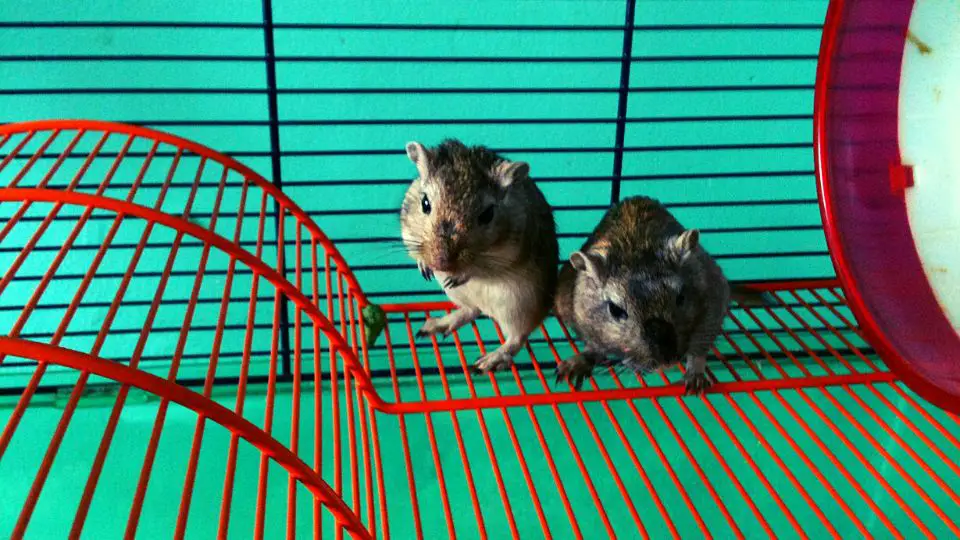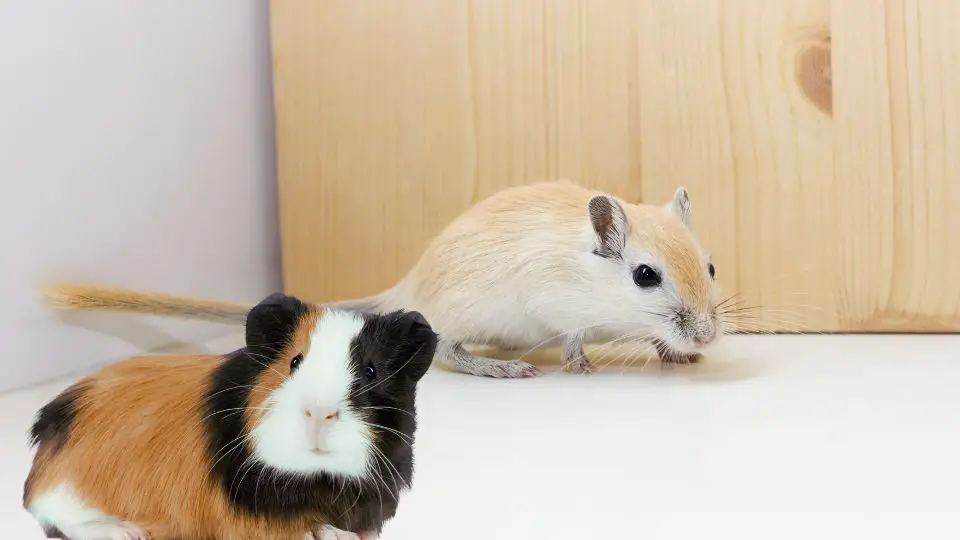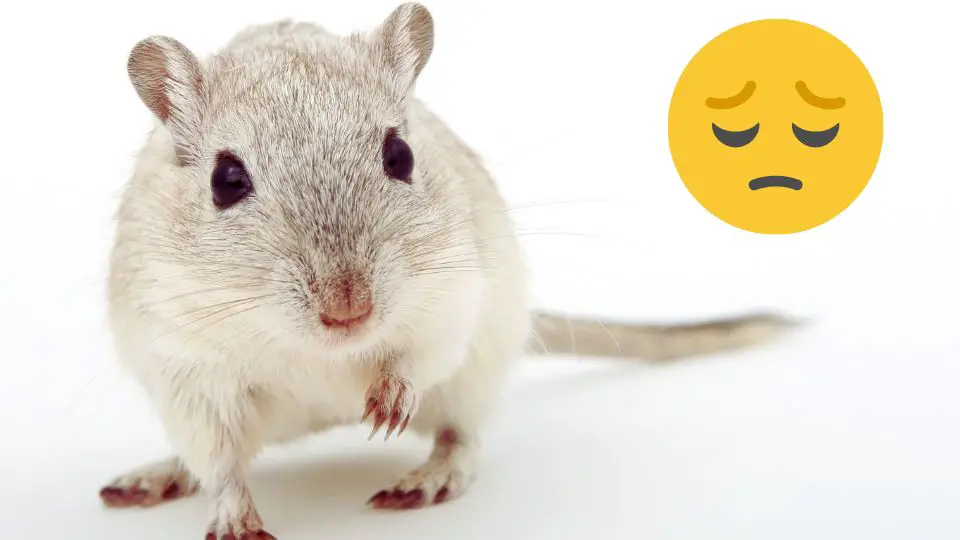If you’re considering adding a gerbil to your family, you’re in for a treat! These adorable and active little pets can make great companions for people of all ages. However, before bringing a gerbil home, it’s important to understand the responsibilities and commitments that come with owning one.
In this guide, we’ll cover everything you need to know about setting up the perfect home for your gerbil, understanding and managing their behavior, creating a healthy diet, and providing enrichment and toys.
We’ll also explore the pros and cons of keeping gerbils as pets, and help you decide if a gerbil is the right pet for your family. With the right preparation and care, gerbils can make wonderful and loving pets that bring joy to your life.
Gerbils and Behavior: Understanding Your Pet’s Needs
Gerbils are fascinating small animals that make great pets for many families. They are known for their playful and curious nature, but as with any pet, you have to understand their behavior in order to provide them with the best care possible.
Understanding Gerbil Behavior
Gerbils are social animals and thrive on interaction with their owners and other gerbils. They are also active and curious animals that need plenty of space and opportunities to explore. A gerbil’s natural habitat is a burrow in the wild, so they also have a need to burrow and hide.
In captivity, they will appreciate a spacious cage with hiding spots, tubes, and plenty of bedding to burrow in. Providing your gerbil with an environment that mimics their natural habitat can help to prevent behavioral issues from arising.
Common Behavioral Issues in Gerbils
Gerbils are generally easy-going animals, but there are some common behavioral issues that can arise. These include:
- Biting: Gerbils may bite if they feel threatened or are not handled properly.
- Chewing: Gerbils have a natural inclination to chew, so it is important to provide them with plenty of safe things to chew on.
- Digging: Gerbils will naturally want to dig and burrow, so it is important to provide them with a deep layer of bedding in their cage.
- Aggression: Gerbils can become aggressive or territorial if they are not socialized properly.
- Hiding: Gerbils may hide if they feel stressed or are not provided with enough hiding spots in their cage.
Tips for Managing Behavioral Problems in Gerbils
If you notice your gerbil exhibiting any of these behavioral issues, there are a few things you can do to help manage them:
- Provide plenty of space and things to explore in their cage
- Handle your gerbil gently and regularly to help them become accustomed to human contact
- Provide plenty of safe things for your gerbil to chew on
- Use positive reinforcement to train your gerbil
- Be sure to provide your gerbil with plenty of hiding spots and a deep layer of bedding
- Seek advice from a veterinarian if the problem persists
Setting up the Perfect Home for Your Gerbil
Setting up the perfect home for your gerbil doesn’t have to be difficult—it just requires some careful thought and planning! With a spacious cage filled with healthy bedding options, plenty of toys and accessories, and a few safety measures around your home, you can rest assured knowing that you’ve done everything possible to make sure your pet has an ideal living situation.
It’s important to choose a cage that is big enough for your gerbil and allows them plenty of room to explore. The best cages for gerbils will be tall rather than wide, as these give them more vertical space which is essential for their climbing needs.
Our recommendation is a 24 inches (ca. 61 cm) long, 12 inches (ca. 30 cm) wide, 12 inches tall cage with a secure lid, as this will provide plenty of room for your gerbil to play and explore.
Look for cages with multiple levels and plenty of places to hide—a few tubes or tunnels will do the trick. Make sure you choose one with good ventilation too!
Bedding and Substrate Options
When it comes time to line your gerbil’s cage, there are several options available. Most pet stores carry bedding specifically designed for small animals like hamsters and gerbils. You can also use shredded paper or newspaper as bedding.
Whichever you use, avoid cedar or pine chips; these can be dangerous if ingested by your pet. As an alternative option, many owners opt to line their cages with sand substrate which mimics the natural environment of wild gerbils in the desert.
Essential Accessories and Furnishings
Your gerbil will need some things in their cage beyond just bedding. Make sure there are plenty of toys available—some natural pieces like sticks from outside or cardboard tubes from toilet paper rolls can provide hours of entertainment!
You should also include a wheel; not only does this give them exercise but it simulates running in the wild too! Finally, don’t forget about a water bottle; this is essential for keeping your gerbil hydrated throughout the day.
Gerbil-Proofing Your Home
Since they’re small and nimble creatures, you should take steps to make sure that your entire home is “gerbil-proofed.” This means checking all other rooms in the house where they may be able to escape into potential danger, such as behind furniture or underneath appliances—particularly if they have wheels on them!
Be sure to keep all electrical cords out of reach since these can be hazardous if chewed on by curious little paws. Lastly, keep any toxic materials away from your pet’s enclosure so that they stay safe at all times.
Handling and Bonding with Your Gerbil
When it comes to keeping gerbils as pets, one of the most important aspects is how you bond and handle your pet. Gerbils are social animals and thrive when they have regular interaction with their owners.
Each gerbil has its own unique personality and you must take the time to get to know yours. Some gerbils may be more outgoing and enjoy being handled, while others may be more timid and prefer to be left alone. By observing your gerbil’s behavior, you’ll learn what they enjoy and what they don’t like.
Tips for Handling Your Gerbil
Once you have a good understanding of your gerbil’s personality, you can start to handle them. Here are some tips:
- Take it slow: Allow your gerbil to get used to you and their new surroundings before attempting to handle them.
- Use a calm and gentle approach: Speak softly and move slowly around your gerbil to avoid scaring them.
- Use a flat hand: When picking up your gerbil, use a flat hand to support their body and avoid squeezing or gripping too tightly.
- Let your gerbil come to you: Encourage your gerbil to approach you by offering them treats or by simply sitting quietly and letting them explore you.
- Be consistent: Establish a routine for handling your gerbil so they know what to expect and feel more comfortable with you.
- Provide plenty of playtime: Give your gerbil plenty of opportunities to play and explore, this will help them to feel more comfortable with you.
- Provide plenty of socialization: Gerbils are social animals and need the company of other gerbils or human interaction to stay happy and healthy.
- Have patience: bonding with a gerbil takes time and patience, it won’t happen overnight.
- Watch their body language: Learn to read your gerbil’s body language to understand when they are feeling comfortable or stressed.
- Give them a hiding spot: Gerbils need a place where they can retreat and feel safe, a hiding spot or a nest box is ideal for this.
Understanding Gerbil Body Language
In order to better understand your gerbil, you have to learn to read their body language. Gerbils communicate through a variety of vocalizations and physical cues. For example, a gerbil that is relaxed and content will have its ears perked up and its tail will be held upright.
On the other hand, a gerbil that is feeling threatened may have its ears flat against its head and its tail may be puffed up. By learning to read your gerbil’s body language, you’ll be able to better understand their needs and respond appropriately.
Tips for Introducing Gerbils
If you have multiple gerbils, it’s important to introduce them properly to avoid any conflicts. Start by keeping them in separate cages and allowing them to sniff each other through the bars. Once they seem comfortable with each other, you can place them in a neutral area, such as a playpen, for supervised playtime. Gradually increase the amount of time they spend together and always keep an eye out for any aggressive behavior.
Overall, handling and bonding with your gerbil is an essential aspect of pet ownership. By understanding your gerbil’s behavior and personality, you’ll be able to create a stronger bond and provide the best possible care for your pet.
Feeding Your Gerbil
Gerbils are active pets that require a diet rich in nutrients to maintain their health. In order to provide your gerbil with the best possible care, it’s essential to understand their nutritional needs and how to properly feed them.
Nutritional Needs of Gerbils
Gerbils are omnivorous and require a diet that includes a balance of proteins, fats, and carbohydrates. They also need a variety of vitamins and minerals, including calcium and phosphorus.
In the wild, gerbils eat a variety of seeds, fruits, vegetables, and insects. In captivity, we must provide them a diet that mimics this natural diet as much as possible.
Feeding Schedule and Portion Sizes
Gerbils should be fed twice a day, once in the morning and once in the evening. The portion size should be based on the age, size, and activity level of your gerbil.
A general guideline is to provide 1-2 tablespoons of food per gerbil, per day. You should monitor your gerbil’s weight and adjust the portion size accordingly.
Recommended Foods for Gerbils
There are several types of food that are suitable for gerbils. These include:
- Commercial gerbil diets: These are specially formulated to meet the nutritional needs of gerbils and can be found at most pet stores.
- Fruits and vegetables: Apples, bananas, carrots, and dark leafy greens are all suitable for gerbils.
- Live insects: Live mealworms or crickets can be offered as occasional treats.
- Treats: Small amounts of unsalted nuts or seeds can be offered as occasional treats.
It’s important to note that gerbils should not be fed high-sugar or high-fat foods, as these can lead to health problems. Additionally, fresh food should be introduced slowly to prevent digestive upset.
Providing your gerbil with a diet that meets their nutritional needs is essential for maintaining their health. Feeding them twice a day, monitoring their weight, and providing a variety of healthy foods are some key aspects of maintaining a healthy diet for your gerbil. With the right diet, your gerbil will be happy, healthy, and active for years to come.
Gerbils and Aging: Understanding the Changes
Gerbils are known for being one of the longest-living small mammals as they can live up to 3 years on average in captivity. That said, some gerbils may live longer depending on genetics and environment. Factors such as diet, exercise, stress, and illnesses can all affect a gerbil’s lifespan.
As such, it’s important that you understand the changes of your gerbil while it’s aging, and you take proper care of your little pets throughout their lives so they can be healthy and happy for as long as possible.
Signs of Aging in Gerbils
The most common sign of aging in gerbils is graying fur around the eyes and muzzle region; however, there are additional signs that may indicate your pet is getting older. Other symptoms include:
- slowing down or becoming less active;
- reduced interest in playtime;
- decreased grooming habits;
- sleeping more during the day instead of at night;
- difficulty walking or climbing;
- weight gain or loss;
- changes in overall energy levels or behavior;
- increased sensitivity to touch due to arthritis;
- disinterest in food or water;
If you notice any changes in your pet’s behavior or health conditions, it’s important that you take them to see a vet right away.
Caring for an Elderly Gerbil
As your pet ages, you must provide them with extra love and care. Give them plenty of time outside their cage each day, but be careful not let them get too tired from playing too much—an elderly gerbil needs plenty of rest!
Make sure your pet has access to clean water at all times as well as fresh vegetables and snacks (like nuts). You can also consider adding extra bedding material like hay into your pet’s cage if they’re having trouble walking around due to age-related mobility issues—this will help cushion their feet when climbing around their home!
And lastly, if your gerbil has trouble hearing or seeing due to age-related issues, make sure that you keep an eye on them when they’re out exploring so that nothing bad happens!
Coping With Loss
When it comes time for us to say goodbye to our furry friends, it can be hard—no matter how old they were when they passed away.
It’s important for us as pet owners not only take care of our pets while they’re alive but also remember them after they’ve gone by continuing traditions like taking walks together or making favorite treats together in the kitchen!
By understanding the gerbil aging process and providing them with extra love and care throughout its life cycle, we can ensure our pets have long happy lives filled with lots of love! Taking proper care now will help us prepare better when saying goodbye eventually comes along – whether sooner than expected due too age-related problems or later due longer life expectancy.
Enrichment and Toys for Gerbils
Providing your small pet enrichment and toys is crucial for his physical, mental, and emotional well-being. Enrichment refers to providing gerbils with a variety of activities, environments, and opportunities for exploration and play. Enrichment is essential for gerbils because it:
- Keeps them physically active and healthy
- Stimulates their natural curiosity and intelligence
- Promotes positive behaviors and reduces negative behaviors
- Enhances their overall quality of life
DIY Toy Ideas
Providing a variety of toys and activities can help keep your small pet entertained and engaged. Here are a few ideas for DIY toys that you can make at home:
- Cardboard tunnels and tubes: Gerbils love to explore and tunnel through cardboard. You can make your own cardboard tunnels and tubes by cutting and taping together cardboard boxes.
- Paper towel rolls: Gerbils enjoy gnawing on paper products. Cut paper towel rolls into smaller pieces and place them in the cage for your gerbil to chew on.
- Treat balls: Fill a small plastic ball with small treats or pieces of food and let your gerbil figure out how to get the treats out.
- Tissue paper nest: Gerbils love to make nests. Provide them with a pile of tissue paper and watch them create their own cozy nest.
- Cardboard puzzle: Cut a piece of cardboard into different shapes and holes and let your gerbil figure out how to fit them back together.
- Wooden blocks: Gerbils enjoy gnawing on wood. You can provide them with small wooden blocks to chew on.
We must note that not all gerbils have the same preferences and some may not be interested in certain types of toys. You should observe your gerbil’s behavior and preferences and make adjustments accordingly. Also, we always recommend to regularly rotate the toys you provide to your gerbil to keep them interesting and stimulate their mind.
In addition to providing toys, a spacious cage with plenty of hiding spots, climbing opportunities, and room to run around is required. You should also provide them with a variety of different types of bedding, such as paper-based or aspen shavings, to keep them interested.
Enrichment and toys are an essential part of gerbil care. By providing a variety of activities, environments, and opportunities for exploration and play, you can ensure that your gerbil stays happy, healthy, and engaged. These DIY toy ideas are simple and easy to make, and can be a great way to start providing enrichment for your gerbil.
Pros and Cons of Keeping Gerbils as Pets
Keeping gerbils as pets come with a number of pros and cons depending on the situation. On one hand, gerbils are relatively easy to care for and don’t require a lot of space or maintenance. They’re also very social animals and can be great company for kids. On the other hand, gerbils can be prone to health problems and don’t live very long.
Here is a list of pros and cons of keeping gerbils as pets.
Pros
- Low maintenance
- Cute and playful
- Can be great for kids
- Can be kept in a small space
- Low cost of care
- Low noise level
- Can pe kept in pairs or groups
- Can be easily trained
- Can live for several years
Cons
- Short lifespan
- Requires daily maintenance
- Can be prone to certain health issues
- Can carry parasites
- Can be aggressive or territorial
- Can be an escape risk
- Can have a strong odor
- Can be a potential allergy risk
Deciding if a Gerbil is the Right Pet for Your Family
When considering adding a gerbil to your family, there are a number of factors to take into consideration. Below are some ideas to help you decide if a gerbil is the right pet for your family:
- Commitment: Gerbils have an average lifespan of 2-4 years, so it’s important to be prepared for a long-term commitment.
- Space: Gerbils are active and need space to run and play. They should be kept in a cage that is at least 30 inches long, 18 inches wide and 18 inches tall.
- Time: Gerbils require daily attention and care, including cleaning their cage, providing fresh food and water, and spending time interacting with them.
- Children: Gerbils can make great pets for children, but it’s important to teach children how to handle them gently and responsibly.
- Allergies: Some people may be allergic to gerbils, so it’s important to consider this before bringing one home.
- Cost: Gerbils have a relatively low cost of care, but it’s important to budget for food, bedding, toys, and veterinary care.
- socialization: Gerbils are social animals and do best when kept in pairs or groups, so it’s important to consider if you’re willing to take on the responsibility of multiple gerbils.
- Training: Gerbils can be trained to do simple tricks, but it does require patience and consistency.
- Health: Gerbils can be prone to certain health issues, so it’s important to be prepared for potential veterinary costs.
- Lifestyle: Gerbils are nocturnal animals and can be active during the night, which may not be suitable for everyone.
Ultimately, the decision to bring a gerbil into your family should be based on your ability to provide the necessary care, space, and attention, as well as your personal lifestyle and preferences. It’s important to do your research and carefully consider all the factors before making a decision.
Wrapping up
Overall, keeping gerbils as pets can be a great choice for those who are prepared to commit to their care and provide them with the necessary environment and enrichment activities. While there may be some challenges involved, gerbils make wonderful companions due to their easy-going nature, social behavior, and low cost of care. With proper research and patience, gerbils can make wonderful additions to any family.
With their playful, energetic personalities and long lifespans, gerbils are great pets for those who are looking for a low-maintenance companion. Whether you choose to keep one or multiple gerbils, they can bring much joy and entertainment into your life.
Thank you for reading this overview on keeping gerbils as pets! We hope it has helped equip you with the information needed to make an informed decision. Good luck with your new furry friend!







